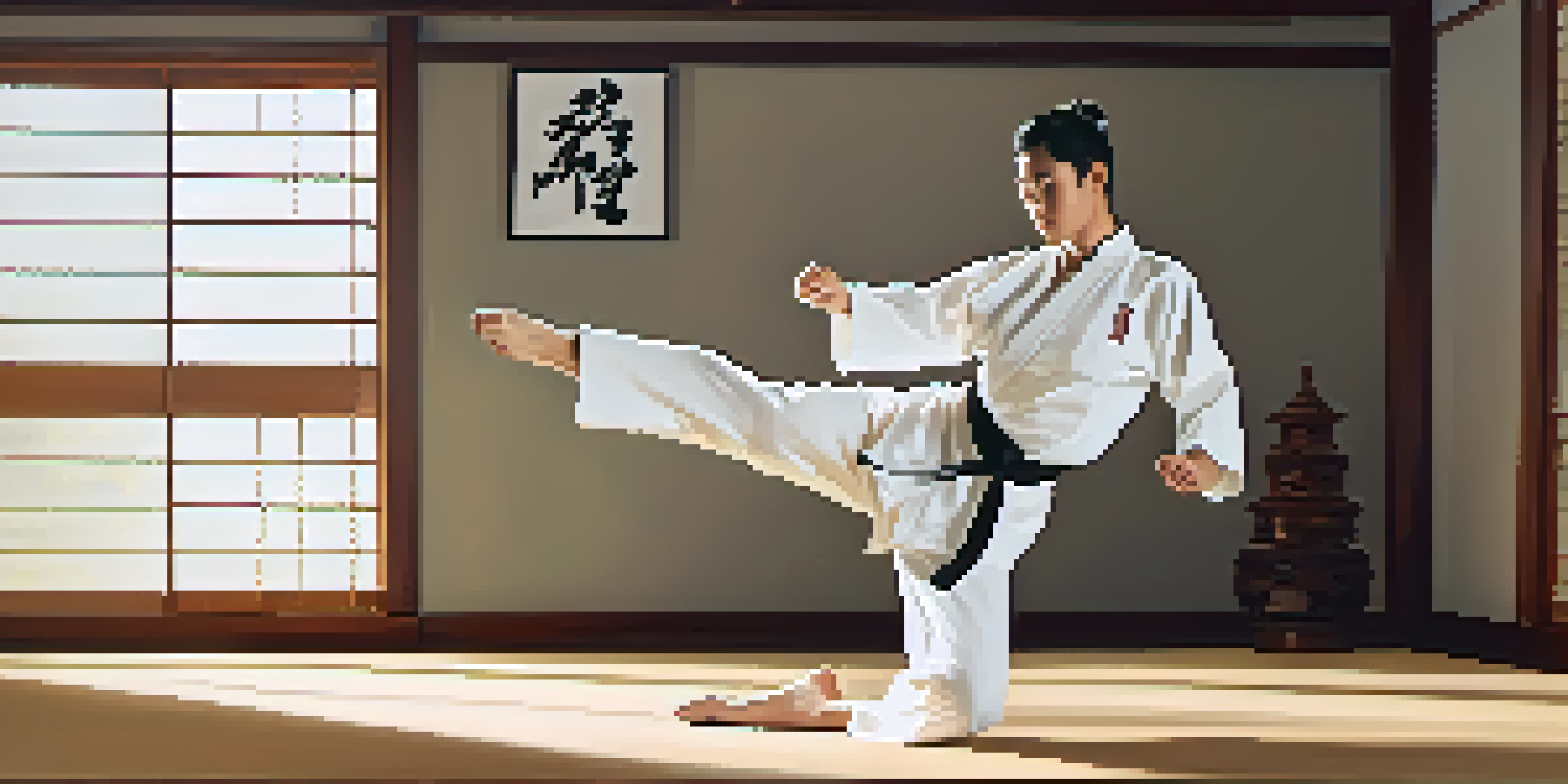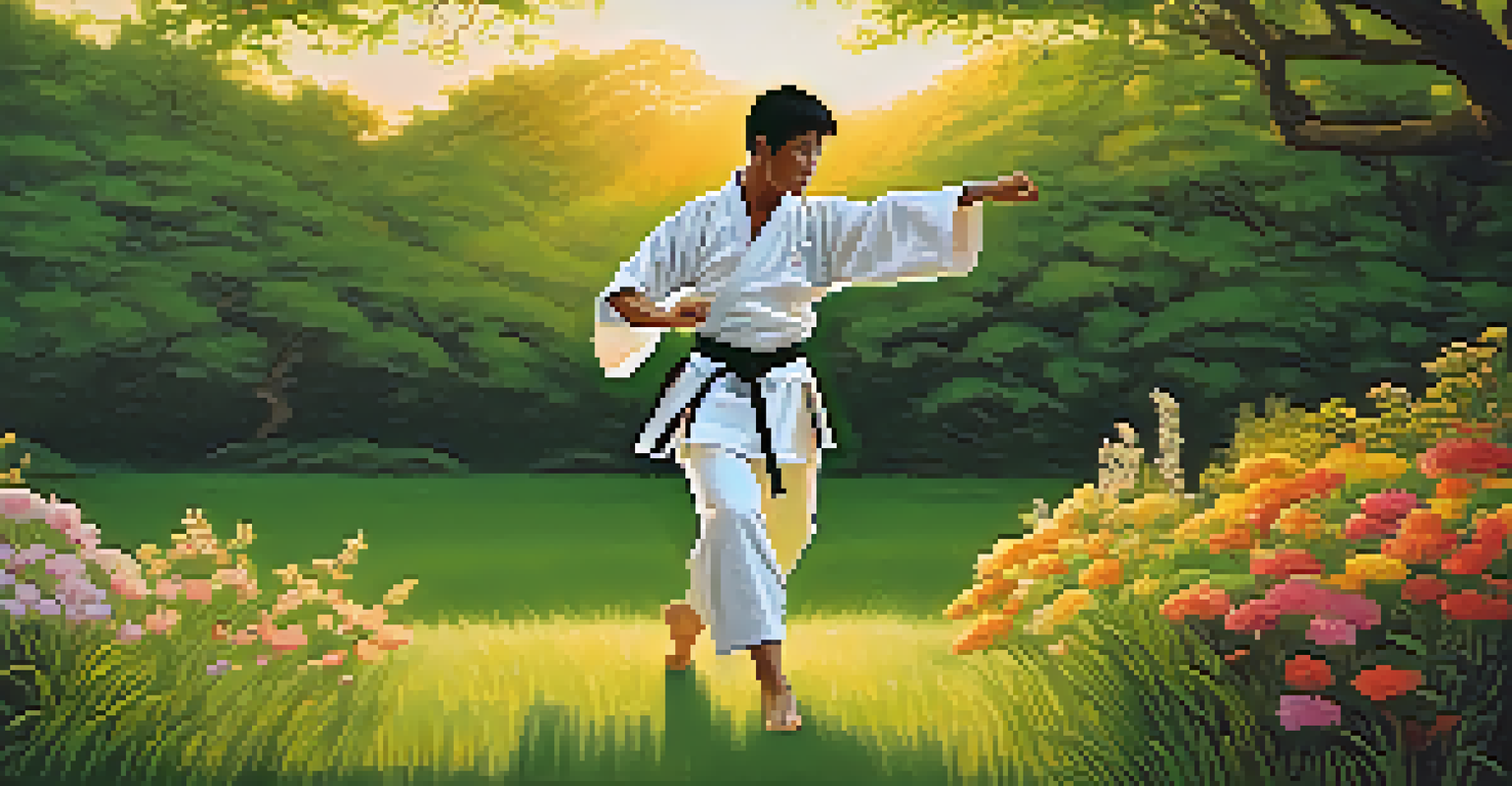How Visualization Techniques Boost Martial Arts Skills

Understanding Visualization in Martial Arts Training
Visualization is a mental technique where practitioners imagine themselves performing skills and techniques. This practice is not just daydreaming; it's a powerful tool that can enhance physical performance. By mentally rehearsing actions, martial artists can improve their focus and muscle memory, allowing them to execute techniques more fluidly.
Visualization is daydreaming with a purpose.
In martial arts, visualization helps athletes see themselves in various scenarios, whether it's executing a perfect kick or anticipating an opponent's move. This mental preparation can lead to greater confidence during actual sparring or competition. Just like a movie director envisions each shot, martial artists can create a mental script for their success.
The brain doesn’t distinguish between real and imagined experiences, so the more vivid the visualization, the more effective it can be. For example, a fighter visualizing a successful match can mentally prepare for the challenges they’ll face, making them feel more ready when the time comes.
The Science Behind Visualization Techniques
Research has shown that visualization can activate the same neural pathways in the brain as physical practice. This means that when martial artists visualize their moves, they are essentially training their brains to execute those moves more effectively. It’s like running a rehearsal before the big performance, allowing the body to respond instinctively during the actual event.

Studies indicate that athletes who regularly use visualization techniques often outperform those who don’t. This difference can be attributed to improved mental clarity and reduced anxiety during competitions. Just as a musician practices scales before a recital, athletes can mentally prepare to refine their skills.
Visualization Enhances Performance
Practicing mental imagery allows martial artists to improve focus, muscle memory, and overall execution of techniques.
Moreover, visualization can help in recovery from injuries by maintaining a connection to the sport. Many athletes visualize their movements during recovery to ensure they don’t lose muscle memory, which keeps them engaged and motivated while healing.
Enhancing Focus Through Visualization Techniques
Martial arts require intense concentration, and visualization can significantly enhance focus. By picturing their techniques and strategies, practitioners can tune out distractions and hone in on their performance. Visualization acts as a mental warm-up, aligning the mind with the body before training or competition.
The mind is everything. What you think you become.
For instance, before stepping on the mat, a martial artist might visualize their breathing, stance, and first move. This practice not only calms the mind but also sets a clear intention for the session. Just like tuning a guitar before a concert, this preparation ensures everything is in harmony.
Additionally, by regularly practicing visualization, martial artists can develop a stronger mental game. This leads to better decision-making during high-pressure situations, much like a chess player who anticipates moves ahead of time.
Using Visualization for Skill Improvement
Visualization can be particularly effective for mastering complex techniques. By breaking down movements into smaller components and visualizing each step, martial artists can enhance their understanding and execution. This method allows for detailed mental practice without the physical strain.
For example, an athlete struggling with a specific kick can visualize the setup, execution, and follow-through. Each time they mentally rehearse, they build a clearer pathway for their body to follow in real life. Like an architect drafting blueprints, this visualization lays the groundwork for success.
Mental Techniques Reduce Anxiety
Visualization helps athletes manage performance anxiety by mentally rehearsing success in high-pressure situations.
Incorporating visualization into regular training routines can accelerate learning and skill retention. Practitioners who visualize alongside physical practice often notice improvements more quickly, as their brain has already mapped out the movements.
Overcoming Performance Anxiety with Visualization
Performance anxiety is common among martial artists, especially during competitions. Visualization can serve as a powerful antidote to this nervousness. By visualizing themselves succeeding in high-pressure situations, athletes can reframe their mindset and reduce anxiety levels.
Imagine a fighter visualizing their entrance into the arena, imagining the crowd cheering and feeling confident. This mental imagery can transform anxiety into excitement, creating a positive mental state before the match begins. It’s similar to an actor visualizing their lines to calm their nerves before stepping on stage.
Furthermore, consistent visualization can build resilience, empowering martial artists to face challenges head-on. When anxiety arises, recalling positive visualizations can help center their focus and remind them of their capabilities.
Integrating Visualization into Your Training Routine
Incorporating visualization into training doesn’t require a complete overhaul of your routine. Practitioners can dedicate just a few minutes before or after physical training to visualize their movements. This integration can enhance overall effectiveness without consuming much additional time.
Setting aside quiet time to visualize techniques, scenarios, or even successful matches can create a powerful habit. It’s akin to stretching before a workout; it prepares the mind and body for what’s ahead. Creating a consistent visualization practice can lead to profound changes in performance.
Integration Boosts Training Efficiency
Incorporating visualization into regular training routines can accelerate skill learning and retention without requiring extra time.
Additionally, martial artists can use guided imagery or visualization apps designed specifically for athletes. These resources can provide structured practices and techniques to enhance visualization, making it easier to incorporate into daily training.
Success Stories: Visualization in Martial Arts
Numerous elite martial artists credit visualization as a key element in their training. For example, world champions often discuss how they visualize their matches and opponents before stepping onto the mat. These success stories serve as inspiring testimonials to the effectiveness of visualization.
One notable athlete recalled how visualizing each fight strategy helped them remain calm and focused during competitions. When the pressure mounted, their mental rehearsals kicked in, guiding their actions instinctively. This illustrates how visualization can lead to tangible results in high-stress situations.

These anecdotes remind us that visualization isn’t just a theory; it’s a practical tool used by successful martial artists to gain a competitive edge. By following their lead, anyone can harness the power of visualization to elevate their skills and performance.